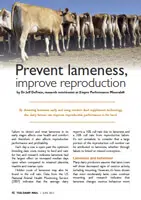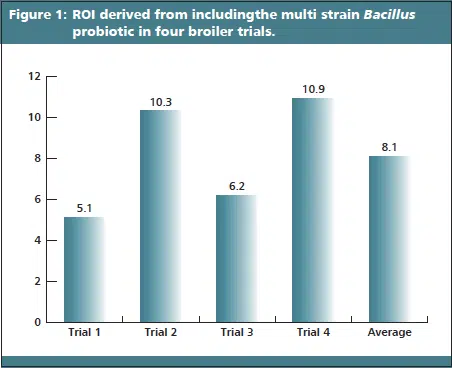By detecting lameness early and using modern feed supplement technology, the dairy farmer can improve reproductive performance in his herd.
Failure to detect and treat lameness in its early stages affects cow health and comfort and therefore it also affects reproductive performance and profitability.
Each day a cow is open past the optimum breeding date costs money to feed and care for her, and research indicates lameness had the largest effect on increased median days open when compared to retained placenta, mastitis and ovarian cysts.
Hidden costs of lameness may also be found in the cull rate. Data from the US National Animal Health Monitoring Service (2007) indicates that the average dairy reports a 16% cull rate due to lameness and a 26% cull rate from reproductive failure. It’s not unrealistic to consider that a large portion of the reproduction cull number can be attributed to lameness, whether through failure to breed or missed conception.
 Lameness and behaviour
Lameness and behaviour
Many dairy producers assume that lame cows will show decreased signs of oestrus activity, including mounting. However, it’s been shown that even moderately lame cows continue mounting, and research indicates that lameness changes oestrus behaviour more than the incidence of oestrus. Cows with a locomotion score of 3 were 2,8 times more likely to have increased days to first service compared to cows with a locomotion score of 1 or 2. It was more diffi cult for these cows to conceive, and they were 8,4 times more likely to be culled from the herd.
Research shows that lame cows continue to ovulate and develop mature follicles, but the timing of these events changes. Lame cows actually ovulate earlier but show oestrus signs later.
Early identification and treatment of lame cows are essential to maintain herd performance. Cows experiencing lameness for five weeks have been shown to have only a 25% recovery rate and a 40% removal rate. Cows lame for one week, however, experienced a 91% recovery rate and an 18% removal rate, demonstrating the benefi t of early identification.
Maximum mineral support
For improved lactation performance, udder health, reproduction and overall hoof condition, use a feed supplement that contains a combination of organic zinc, manganese, copper and cobalt. These trace minerals help dairy cows to improve and maintain reproduction success, immunity, hide and hoof integrity, growth and muscle development, milk production, fibre.
Best medicine
Prevention is still the best medicine, so implement these protocols:
- Make early detection of lameness a priority at the dairy before health and reproductive performance are affected. Locomotion scoring assists in identifying claw disorders before they become acute, painful and costly problems.
- Implement a lameness reduction programme by checking the cows, lifting the feet and taking time to get them balanced one week prior to dry off.
- Trace minerals are critical in building and maintaining strong, healthy feet. A combination of zinc, manganese, copper and cobalt in a highly available and complex form helps to decrease the incidence and severity of common claw lesions.
This article by Dr Jeff DeFrain, a research nutritionist at Zinpro Corporation, is published with the consent of Dairy Now and is part of his presentation at the 2011 meeting of the Dairy Cattle Repro ductive Council. Dairy Now is a publicatio n produced by Zinpro Corp with contributions from the FirstStep® team. The FirstStep® Dairy Lameness Assessment and Prevention Programme provides comprehensive assessment of overall lameness risk factors on a dairy to help manage and prevent lameness.
Chemuniqué empowers feed and food producers with the most innovative animal performance solutions, enabling our clients to consistently advance the efficiency of production.










 Lameness and behaviour
Lameness and behaviour